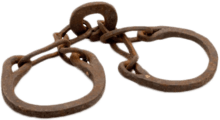White slavery
White slavery (also white slave trade or white slave trafficking) refers to the chattel slavery of Europeans, whether by non-Europeans (such as North Africans and the Muslim world), or by other Europeans (for example naval galley slaves or the Vikings' thralls). Slaves of European origin were present in ancient Rome and the Ottoman Empire.
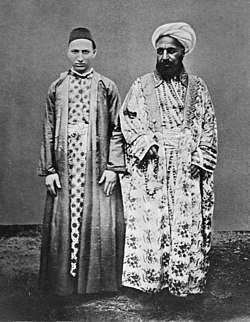
On the European continent under feudalism, there were various forms of status applying to people (such as serf, bordar, villein, vagabond and slave) who were indentured or forced to labor without pay
Under Muslim rule, the Arab slave trades that included Caucasian captives were often fueled by raids into European territories or were taken as children in the form of a blood tax from the families of citizens of conquered territories to serve the empire for a variety of functions.[1] In the mid-19th century, the term 'white slavery' was used to describe the Christian slaves that were sold into the Barbary slave trade.
The modern legal term applies more narrowly to sexual slavery, forced prostitution and human trafficking, with less focus on the race of victims or perpetrators.
History
The phrase "white slavery" was used by Charles Sumner in 1847 to describe the chattel slavery of Christians throughout the Barbary States and primarily in the Algiers, the capital of Ottoman Algeria.[2] It also encompassed many forms of slavery, including the European concubines (Cariye) often found in Turkish harems.[3]
The term was also used by Clifford G. Roe from the beginning of the twentieth century to campaign against the forced prostitution and sexual slavery of girls who worked in Chicago brothels. Similarly, countries of Europe signed in Paris in 1904 an International Agreement for the suppression of the White Slave Traffic aimed at combating the sale of women who were forced into prostitution in the countries of continental Europe.
White slave trade
Slavic Slaves
.jpg)
The Volga trade route was established by the Varangians (Vikings) who settled in Northwestern Russia in the early 9th century. About 10 km (6 mi) south of the Volkhov River entry into Lake Ladoga, they established a settlement called Ladoga (Old Norse: Aldeigjuborg).[4] It connected Northern Europe and Northwestern Russia with the Caspian Sea, via the Volga River. The Rus used this route to trade with Muslim countries on the southern shores of the Caspian Sea, sometimes penetrating as far as Baghdad. The route functioned concurrently with the Dnieper trade route, better known as the trade route from the Varangians to the Greeks, and lost its importance in the 11th century.
Saqaliba originally was used to denote Slavic people, however later it came to denote all European slaves in some Muslim regions like Spain including those abducted from raids on Christian kingdoms of Spain. The Franks started buying slaves from the Slavs and Avar Khaganate while Muslims also came across slaves in the form of mercenaries serving the Byzantine Empire and settlers in addition to among the Khazars. Most Slavic slaves were imported to the Muslim world through the border between Christian and Islamic kingdoms where castration centres were also located instead of the direct route. From there they were sent into Islamic Spain and other Muslim-ruled regions especially North Africa. The saqaliba gained popularity in Umayyad Spain especially as warriors. After the collapse of the Umayyads, they also came to rule over many of the taifas. With the conversion of Eastern Europe, the trade declined and there isn't much textual information on saqaliba after 11th century.[5]
Central Europe was the most favoured destination for importation of slaves alongside Central Asia and Bilad as-Sudan, though slaves from Northwestern Europe were also valued. This slave trade was controlled mostly by European slave traders. France and Venice were the routes used to send Slavic slaves to Muslim lands and Prague served as a major centre for castration of Slavic captives.[6][7] The Emirate of Bari also served as an important port for this trade.[8] Due to the Byzantine Empire and Venice blocking Arab merchants from European ports, they later started importing in slave from the Caucasus and the Caspian Sea.[9]
The Saqaliba were also imported as eunuchs and concubines to Muslim states.[10] The slavery of eunuchs in the Muslim world however was expensive and they thus were given as gifts by rulers. The Saqaliba eunuchs were prominent at the court of Aghlabids and later Fatimids who imported them from Spain. The Fatimids also used other Saqaliba slaves for military purposes.[11]
Crimean Khanate
In the time of the Crimean Khanate, Crimeans engaged in frequent raids into the Danubian principalities, Poland-Lithuania, and Muscovy. For each captive, the khan received a fixed share (savğa) of 10 percent or 20 percent. The campaigns by Crimean forces categorize into sefers, declared military operations led by the khans themselves, and çapuls, raids undertaken by groups of noblemen, sometimes illegally because they contravened treaties concluded by the khans with neighbouring rulers. For a long time, until the early 18th century, the khanate maintained a massive slave trade with the Ottoman Empire and the Middle East. Caffa was one of the best known and significant trading ports and slave markets.[12] Crimean Tatar raiders enslaved between 1 and 2 million slaves from Russia and Poland-Lithuania over the period 1500–1700.[13][14] Caffa (city on Crimean peninsula) was one of the best known and significant trading ports and slave markets.[15][16] In 1769, a last major Tatar raid resulted in the capture of 20,000 Russian and Ruthenian slaves.
Barbary slave trade
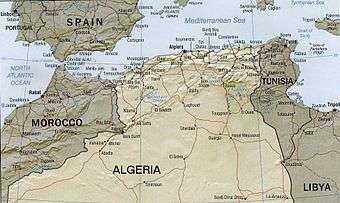

Slave markets flourished on the Barbary Coast of North Africa, in what is modern-day Morocco, Algeria, Tunisia, and western Libya, between the 15th and middle of the 18th century.
These markets prospered while the states were nominally under Ottoman suzerainty, though, in reality, they were mostly autonomous. The North African slave markets traded in European slaves which were acquired by Barbary pirates in slave raids on ships and by raids on coastal towns from Italy to Spain, Portugal, France, England, the Netherlands, and as far afield as the Turkish Abductions in Iceland. Men, women, and children were captured to such a devastating extent that vast numbers of sea coast towns were abandoned.
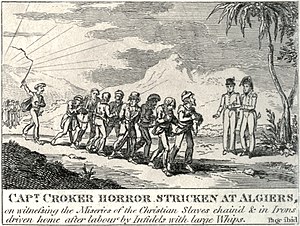
According to Robert Davis, between 1 million and 1.25 million Europeans were captured by Barbary pirates and sold as slaves in North Africa and Ottoman Empire between the 15th and 19th centuries.[17][18] However, to extrapolate his numbers, Davis assumes the number of European slaves captured by Barbary pirates were constant for a 250-year period, stating:
There are no records of how many men, women and children were enslaved, but it is possible to calculate roughly the number of fresh captives that would have been needed to keep populations steady and replace those slaves who died, escaped, were ransomed, or converted to Islam. On this basis it is thought that around 8,500 new slaves were needed annually to replenish numbers - about 850,000 captives over the century from 1580 to 1680. By extension, for the 250 years between 1530 and 1780, the figure could easily have been as high as 1,250,000."[19]
Davis' numbers have been challenged by other historians, such as David Earle, who cautions that true picture of Europeans slaves is clouded by the fact the corsairs also seized non-Christian whites from eastern Europe and black people from west Africa.[19] A second book by Davis, Holy War and Human Bondage: Tales of Christian-Muslim Slavery in the Early-Modern Mediterranean, widened its focus to related slavery.[20]
It is also worth noting that there were wide fluctuations year-to-year, particularly in the 18th and 19th centuries, and also given the fact that, prior to the 1840s, there are no consistent records. Middle East expert, John Wright, cautions that modern estimates are based on back-calculations from human observation.[21]
Such observations, across the late 1500s and early 1600s observers, account for around 35,000 European Christian slaves held throughout this period on the Barbary Coast, across Tripoli, Tunis, but mostly in Algiers. The majority were sailors (particularly those who were English), taken with their ships, but others were fishermen and coastal villagers. However, most of these captives were people from lands close to Africa, particularly Spain and Italy.[22]
From bases on the Barbary coast, North Africa, the Barbary pirates raided ships traveling through the Mediterranean and along the northern and western coasts of Africa, plundering their cargo and enslaving the people they captured. From at least 1500, the pirates also conducted raids along seaside towns of Italy, Spain, France, England, the Netherlands and as far away as Iceland, capturing men, women and children. On some occasions, settlements such as Baltimore, Ireland were abandoned following the raid, only being resettled many years later. Between 1609 and 1616, England alone had 466 merchant ships lost to Barbary pirates.[23]
While Barbary corsairs looted the cargo of ships they captured, their primary goal was to capture people for sale as slaves or for ransom. Those who had family or friends who might ransom them were held captive, but not obliged to work; the most famous of these was the author Miguel de Cervantes, who was held for almost five years. Others were sold into various types of servitude. Attractive women or boys could be used as sex slaves. Captives who converted to Islam were generally freed, since enslavement of Muslims was prohibited; but this meant that they could never return to their native countries.[24][25]
16th- and 17th-century customs statistics suggest that Istanbul's additional slave import from the Black Sea may have totaled around 2.5 million from 1450 to 1700.[26] The markets declined after the loss of the Barbary Wars and ended in the 1830s, when the region was conquered by France.
Christian slavery in Muslim Spain
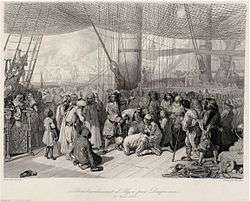
During the Al-Andalus (also known as Muslim Spain or Islamic Iberia), the Moors controlled much of the peninsula. They imported white Christian slaves from the 8th century until the Reconquista in the late 15th century. The slaves were exported from the Christian section of Spain, as well as Eastern Europe, sparking significant reaction from many in Christian Spain and many Christians still living in Muslim Spain. Soon after, Muslims were successful, taking 30,000 Christian captives from Spain. In the eighth century slavery lasted longer due to "frequent cross-border skirmishes, interspersed between periods of major campaigns". By the tenth century, in the eastern Mediterranean Byzantine, Christians were captured by Muslims. Many of the raids designed by Muslims were created for a fast capture of prisoners. Therefore, Muslims restricted the control in order to keep captives from fleeing. The Iberian peninsula served as a base for further exports of slaves into other Muslim regions in Northern Africa.[27]
Ottoman slave trade
Slavery was a legal and a significant part of the Ottoman Empire's economy and society.[28] The main sources of slaves were war captives and organized enslavement expeditions in Africa, Eastern Europe, and Circassia and Georgia in the Caucasus. It has been reported that the selling price of slaves fell after large military operations.[29] Enslavement of Europeans was banned in the early 19th century, while slaves from other groups were allowed.[30]
Even after several measures to ban slavery in the late 19th century, the practice continued largely unabated into the early 20th century. As late as 1908, female slaves were still sold in the Ottoman Empire.[31] Sexual slavery was a central part of the Ottoman slave system throughout the history of the institution.[32][33]
European slavery
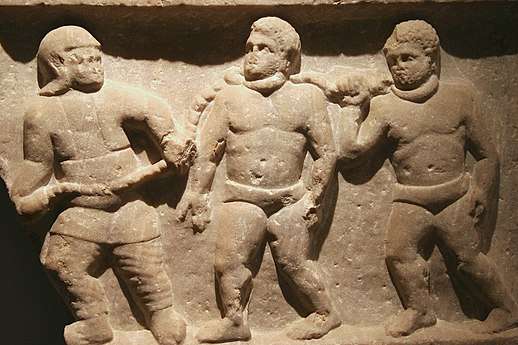
Slavery in ancient Rome
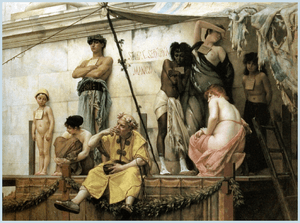
In the Roman Republic and later Roman Empire, slaves accounted for most of the means of industrial output in Roman commerce. Slaves were drawn from all over Europe and the Mediterranean, including Gaul, Hispania, North Africa, Syria, Germania, Britannia, the Balkans, and Greece. Generally, slaves in Italy were indigenous Italians,[34] with a minority of foreigners (including both slaves and freedmen) born outside of Italy estimated at 5% of the total in the capital, where their number was largest, at its peak.
Slaves numbering in the tens of thousands were condemned to work in the mines or quarries, where conditions were notoriously brutal. Damnati in metallum ("those condemned to the mine") were convicts who lost their freedom as citizens (libertas), forfeited their property (bona) to the state, and became servi poenae, slaves as a legal penalty. Their status under the law was different from that of other slaves; they could not buy their freedom, be sold, or be set free. They were expected to live and die in the mines.[35] Imperial slaves and freedmen (the familia Caesaris) worked in mine administration and management.[36]
In the Late Republic, about half the gladiators who fought in Roman arenas were slaves, though the most skilled were often free volunteers.[37] Successful gladiators were occasionally rewarded with freedom. However, gladiators being trained warriors and having access to weapons, were potentially the most dangerous slaves. At an earlier time, many gladiators had been soldiers taken captive in war. Spartacus, who led the great slave rebellion of 73-71 BCE, was a rebel gladiator.
The slaves imported in Italy were native Europeans, and very few of them were from outside Europe. This has been confirmed by biochemical analysis of 166 skeletons from three imperial-era cemeteries in the vicinity of Rome (where the bulk of the slaves lived), which shows that only one individual came from outside of Europe (North Africa), and another two possibly did, but results are inconclusive. In the rest of the Italian peninsula, the fraction of non European slaves was much lower than that.[38][39]
Slavery under Islamic rule
| History of the Ottoman Empire |
| Social structure |
|---|
| Court and aristocracy |
| Millets |
| Rise of nationalism |
The "pençik" or "penç-yek" tax, meaning "one fifth", was a taxation based on a verse of the Quran; whereby one fifth of the spoils of war belonged to God, to Muhammad and his family, to orphans, to those in need and to travelers. This eventually included slaves and war captives were given to soldiers and officers to help motivate their participation in wars.[29]
Christians and Jews, known as People of the Book in Islam, were considered dhimmis in territories under Muslim rule, a status of second-class citizens that were afforded limited freedoms, legal protections, personal safety, and were allowed to "practice their religion, subject to certain conditions, and to enjoy a measure of communal autonomy". In order to keep these protections and rights, the protected people were required to pay the annual jizya and kharaj taxes as an acknowledgement of Muslim rule. According to Abu Yusuf, Failure to pay this tax should render the protected person's life and property void and subject the protected person to forced conversion, enslavement, imprisonment or death.[40] If anyone had agreed to pay the jizya, leaving Muslim territory for enemy land was punishable by enslavement if captured.[41]
Failure to pay the yearly tax was commonly punished by house arrest and some legal authorities allowed enslavement of the protected people for non-payment of taxes.[42][43][44] In South Asia, for example, seizure of protected families upon their failure to pay annual tax was one of the two significant sources of slaves sold in the slave markets of Delhi Sultanate and Mughal era.[45]
The Devshirme was a blood tax largely imposed in the Balkans and Anatolia[46] in which the Ottoman Empire sent military to collect Christian boys between the ages of 8 to 18 that were taken from their families and raised to serve the empire.[47] The tax was imposed by Murad I in the mid 1300s and lasted until the reign of Ahmet III in the early 1700s. From the mid to late 14th, through early 18th centuries, the devşirme–janissary system enslaved an estimated 500,000 to one million non–Muslim adolescent males.[48] These boys would attain a great education and high social standing after their training and forced conversion to Islam.[49] Basilike Papoulia wrote that "...the devsirme was the 'forcible removal', in the form of a tribute, of children of the Christian subjects from their ethnic, religious and cultural environment and their transportation into the Turkish-Islamic environment with the aim of employing them in the service of the Palace, the army, and the state, whereby they were on the one hand to serve the Sultan as slaves and freedmen and on the other to form the ruling class of the State."[50]
Indentured servitude
In the modern era, many whites in Britain, Ireland and British North America were indentured servants, a form of slavery now banned by the Universal Declaration of Human Rights, but not all had the comfort of having the documentation of being indentured, and some indentured servants were treated just as badly as their African brethren. Sterling Professor of history at Yale University David Brion Davis wrote that:[51]
- From Barbados to Virginia, colonists long preferred English or Irish indentured servants as their main source of field labor; during most of the seventeenth century they showed few scruples about reducing their less fortunate countrymen to a status little different from chattel slaves - a degradation that was being carried out in a more extreme and far more extensive way with respect to the peasantry in contemporary Russia. The prevalence and suffering of white slaves, serfs and indentured servants in the early modern period suggests that there was nothing inevitable about limiting plantation slavery to people of African origin.
Between 50 and 67 percent of white immigrants to the American colonies, from the 1630s and American Revolution, had traveled under indenture.[52] Many women brought to the colonies were poor, some were abandoned or young girls born out of wedlock, others prostitutes or criminals. One ship's captain reportedly described them as a "villainous and demoralized lot". Many were transported against their will and for profit to Virginia and Maryland. The French transported women from the Salpêtrière prison for the homeless, insane and criminal to New Orleans.[53]
Women held at Salpêtrière were bound in chains, flogged and lived in generally poor and unsanitary conditions. Female inmates, some of whom were sick with venereal disease, were forced to attend confessions three times each day where they would be whipped if their demeanor and behaviors were not acceptably penitent.[54] In addition to Salpêtrière, the French transported women from other almshouses and hospitals including Bicêtre, Hôpital général de Paris and Pitié.[53]
White slave traffic
The International Agreement for the suppression of the White Slave Traffic is a series of anti–human trafficking treaties, the first of which was first negotiated in Paris in 1904. It was one of the first multilateral treaties to address issues of slavery and human trafficking. The Slavery, Servitude, Forced Labour and Similar Institutions and Practices Convention of 1926 and the International Convention for the Suppression of the Traffic in Women of Full Age of 1933 are similar documents.
White Slave Traffic Act of 1910
To battle sex trafficking in the United States, in 1910 the US Congress passed the White Slave Traffic Act (better known as the Mann Act), which made it a felony to transport women across state borders for the purpose of "prostitution or debauchery, or for any other immoral purpose." As more women were being trafficked from foreign countries, the US began passing immigration acts to curtail aliens from entering the country such as the Emergency Quota Act of 1921 and the Immigration Act of 1924. Following the banning of immigrants during the 1920s, human trafficking was not considered a major issue until the 1990s.[55][56]
Criminal Law Amendment (White Slave Traffic) Bill
An attempt was made to introduce a similar law into the UK between 1910 and 1913 as the Criminal Law Amendment Act 1912. Arthur Lee would state in the House of Commons: "the United Kingdom, and particularly England, is increasingly becoming a clearing-house and depot and dispatch centre of the white slave traffic, and the headquarters of the foreign agents engaged in the most expensive and lucrative phase of the business."[57] South America was stated as the main destination for the trafficked girls. The Spectator commented that "the Bill has been blocked by a member [alluding to Frederick Booth ] or members who, for various reasons consider that it is not a measure which ought to be placed upon the statute book" as it would affect the liberty of the individual.[58]
Further reading
- Charles Sumner (1847). White Slavery in the Barbary States: A lecture before the Boston Mercantile Library Association, Feb. 17, 1847. ISBN 978-1092289818.
See also
- Slavery in medieval Europe
- Slavery in Africa
- Slave narrative#North African slave narratives
- Kapi Agha
- Ghilman
- Mamluk
- Turkish Abductions
- Guðríður Símonardóttir
- Jan Janszoon
- Ólafur Egilsson
- Rumelia
- Rumelia Eyalet
- Seljuk Empire
- 1926 Slavery Convention
- Slavery in antiquity
- White slave propaganda
- White-Slave Traffic Act
References
- Shaw, Stanford (1976). History of the Ottoman Empire and Modern Turkey, Volume I. Cambridge: Cambridge University Press. ISBN 0-521-21280-4.
- Sumner, Charles (1847). White Slavery in The Barbary States. A Lecture Before The Boston Mercantile Library Association, Feb. 17, 1847. Boston: William D. Ticknor and Company. p. 4. ISBN 978-1092289818.
I propose to consider the subject of White Slavery in Algiers, or perhaps is might be more appropriately called, White Slavery in the Barbary States. As Algiers was its chief seat, it seems to have acquired a current name for the place. This I shall not disturb; though I shall speak of white slavery, or the slavery of Christians, throughout the Barbary States.
- Sumner, Charles (1847). White Slavery in The Barbary States. A Lecture Before The Boston Mercantile Library Association, Feb. 17, 1847. Boston: William D. Ticknor and Company. p. 54. ISBN 978-1092289818.
Among the concubines of a prince of Morocco were two slaves of the age of fifteen, one of English, and the other of French extraction. - Lampiere's Tour, p. 147. There is an account of "One Mrs. Shaw, an Irishwoman," in words hardly polite enough to be quoted. She was swept into the harem of Muley Shmael, who "forced her to turn moor";"but soon after, having taken a dislike to her, he gave her to a soldier." - Braithwaite's Morocco, p. 191.
- Brøndsted (1965), pp. 64–65
- Historical Encyclopedia of World Slavery saqaliba&f=false The Historical Encyclopedia of World Slavery: A-K ; Vol. II, L-Z, by Junius P. Rodriguez
- Charlemagne, Muhammad, and the Arab Roots of Capitalism by Gene W. Heck. Munich: Walter de Gruyter. 2009. p. 316. ISBN 978-3-406-58450-3.
- Atlas of the Year 1000. Munich: Harvard University Press. 2009. p. 72. ISBN 978-3-406-58450-3.
- 12th century Europe: an interpretive essay. p. 62.
- Critical Readings on Global Slavery (4 vols.). pp. 653, 654.
- Pulcini, Theodore; Laderman, Gary (1998). Exegesis as Polemical Discourse: Ibn Ḥazm on Jewish and Christian Scriptures. Scholars Press. ISBN 9780788503955.
- Lev, Yaacov (1991). State and Society in Fatimid Egypt. BRILL. ISBN 9789004093447.
- Historical survey > Slave societies
- Galina I. Yermolenko (15 July 2010). Roxolana in European Literature, History and Culture. Ashgate Publishing, Ltd. p. 111. ISBN 978-0-7546-6761-2. Retrieved 31 May 2012.
- Darjusz Kołodziejczyk, as reported by Mikhail Kizilov (2007). "Slaves, Money Lenders, and Prisoner Guards:The Jews and the Trade in Slaves and Captivesin the Crimean Khanate". The Journal of Jewish Studies. p. 2.
- "slavery | Definition, History, & Facts". Encyclopedia Britannica. Retrieved 2019-07-03.
- "Feodosiya | Ukraine". Encyclopedia Britannica. Retrieved 2019-07-03.
- Davis, Robert. Christian Slaves, Muslim Masters: White Slavery in the Mediterranean, the Barbary Coast and Italy, 1500-1800.
- "When Europeans were slaves: Research suggests white slavery was much more common than previously believed", Research News, Ohio State University
- Carroll, Rory; correspondent, Africa (2004-03-11). "New book reopens old arguments about slave raids on Europe". The Guardian. ISSN 0261-3077. Retrieved 2017-12-11.
- Robert Davis, Holy War and Human Bondage: Tales of Christian-Muslim Slavery in the Early-Modern Mediterranean, Praeger Series on the Early Modern World (2010). ISBN 978-0275989507
- Wright, John (2007). "Trans-Saharan Slave Trade". Routledge.
- Davis, Robert (17 Feb 2011). "British Slaves on the Barbary Coast". BBC.
- Rees Davies, "British Slaves on the Barbary Coast", BBC, 1 July 2003
- Diego de Haedo, Topografía e historia general de Argel, 3 vols., Madrid, 1927-29.
- Daniel Eisenberg, "¿Por qué volvió Cervantes de Argel?", in Ingeniosa invención: Essays on Golden Age Spanish Literature for Geoffrey L. Stagg in Honor of his Eighty-Fifth Birthday, Newark, Delaware, Juan de la Cuesta, 1999, ISBN 9780936388830, pp. 241-253, http://www.cervantesvirtual.com/obra/por-qu-volvi-cervantes-de-argel-0/, retrieved 11/20/2014.
- The Cambridge World History of Slavery: Volume 3, AD 1420–AD 1804
- Trade and traders in Muslim Spain, Fourth Series, Cambridge University Press, 1996.
- Supply of Slaves
- Spyropoulos Yannis, Slaves and freedmen in 17th- and early 18th-century Ottoman Crete, Turcica, 46, 2015, p. 181, 182.
- Ottomans against Italians and Portuguese about (white slavery).
- Eric Dursteler (2006). Venetians in Constantinople: Nation, Identity, and Coexistence in the Early Modern Mediterranean. JHU Press. p. 72. ISBN 978-0-8018-8324-8.
- Wolf Von Schierbrand (28 March 1886). "Slaves sold to the Turk; How the vile traffic is still carried on in the East. Sights our correspondent saw for twenty dollars--in the house of a grand old Turk of a dealer" (PDF). The New York Times. Retrieved 19 January 2011.
- Madeline C. Zilfi Women and slavery in the late Ottoman Empire Cambridge University Press, 2010
- Santosuosso, Antonio (2001). Storming the Heavens. Westview Press. pp. 43–44. ISBN 978-0-8133-3523-0.
- Alfred Michael Hirt, Imperial Mines and Quarries in the Roman World: Organizational Aspects 27–BC AD 235 (Oxford University Press, 2010), sect. 3.3.
- Hirt, Imperial Mines and Quarries, sect. 4.2.1.
- Alison Futrell, A Sourcebook on the Roman Games (Blackwell, 2006), p. 124.
- Prowse, Tracy L.; Schwarcz, Henry P.; Garnsey, Peter; Knyf, Martin; MacChiarelli, Roberto; Bondioli, Luca (2007). "Isotopic evidence for age-related immigration to imperial Rome". American Journal of Physical Anthropology. 132 (4): 510–519. doi:10.1002/ajpa.20541. PMID 17205550.
- Killgrove, Kristina; Montgomery, Janet (2016). "Killgrove and Montgomery. "All Roads Lead to Rome: Exploring Human Migration to the Eternal City through Biochemistry of Skeletons from Two Imperial-Era Cemeteries (1st-3rd c AD)"". PLOS ONE. 11 (2): e0147585. doi:10.1371/journal.pone.0147585. PMC 4749291. PMID 26863610.
- Lewis, Bernard (1984). The Jews of Islam. Princeton University Press. pp. 14–15. ISBN 978-0-691-00807-3.
- Humphrey Fisher (2001), Slavery in the History of Muslim Black Africa. NYU Press. p. 47.
- Lewis, Bernard (1992). Race and Slavery in the Middle East: An Historical Enquiry. Oxford University Press. pp. 7. ISBN 978-0195053265.
[...] those who remained faithful to their old religions and lived as protected persons under Muslim rule could not, if free, be legally enslaved unless they had violated the terms of being a protected subject, the contract governing their status, as for example by rebelling against Muslim rule or helping the enemies of the Muslim state or, according to some authorities, by withholding payment of the agricultural or yearly tax, the taxes due from protected people to the Muslim state.
- Mark R. Cohen (2005), Poverty and Charity in the Jewish Community of Medieval Egypt, Princeton University Press, ISBN 978-0691092720, pp. 120–3; 130–8, Quotes: "Family members were held responsible for individual's poll tax (mahbus min al-jizya)"; "Imprisonment for failure to pay (poll tax) debt was very common"; "This imprisonment often meant house arrest... which was known as tarsim"
- I. P. Petrushevsky (1995), Islam in Iran, SUNY Press, ISBN 978-0-88706-070-0, pp 155, Quote - "The law does not contemplate slavery for debt in the case of Muslims, but it allows the enslavement of Dhimmis for non-payment of jizya and kharaj.(...) "
- Scott C. Levi (2002), "Hindu Beyond Hindu Kush: Indians in the Central Asian Slave Trade." Journal of the Royal Asiatic Society, 12, Part 3 (November 2002): p. 282
- Perry Anderson (1979). Lineages of the Absolutist State. Verso. pp. 366–. ISBN 978-0-86091-710-6.
- Pollard, Elizabeth (2015). Worlds Together Worlds Apart. W.W. Norton & Company. p. 395. ISBN 978-0-393-92207-3.
- A. E. Vacalopoulos. The Greek Nation, 1453–1669, New Brunswick, New Jersey, Rutgers University Press, 1976, p. 41; Vasiliki Papoulia, The Impact of Devshirme on Greek Society, in War and Society in East Central Europe, Editor—in—Chief, Bela K. Kiraly, 1982, Vol. II, pp. 561—562.
- David Nicolle (1995-05-15), The Janissaries, p. 12, ISBN 9781855324138
- Some Notes on the Devsirme, Bulletin of the School of Oriental and African Studies, Vol. 29, No. 1, 1966, V.L.Menage, (Cambridge University Press, 1966), 64.
- In the Image of God Religion, Moral Values, and Our Heritage of Slavery page 144
- Galenson 1984: 1
- Baker, David V. (2016). Women and Capital Punishment in the United States: An Analytical History.
- Merians, Linda Evi. The Secret Malady: Venereal Disease in Eighteenth-century Britain and France.
- Candidate, Jo Doezema Ph.D. "Loose women or lost women? The re-emergence of the myth of white slavery in contemporary discourses of trafficking in women." Gender issues 18.1 (1999): 23-50.
- Donovan, Brian. White slave crusades: race, gender, and anti-vice activism, 1887-1917. Urbana and Chicago: University of Illinois Press, 2006.
- Hansard CRIMINAL LAW AMENDMENT (WHITE SLAVE TRAFFIC) BILL. HC Deb 10 June 1912 vol 39 cc571-627
- "CRIMINAL LAW AMENDMENT (WHITE SLAVE TRAFFIC). » 11 May 1912 » The Spectator Archive". The Spectator Archive. Retrieved 2019-07-03.
